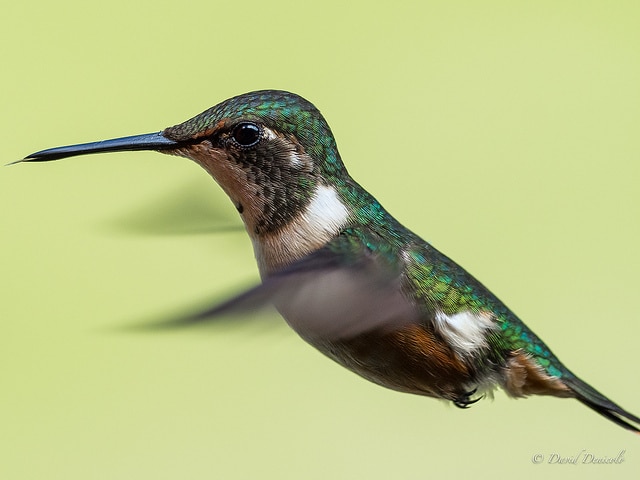
The birds and the bees: Research implicates pollinator-toxic pesticides in hummingbird declines
by Jason Davidson, food and technology campaign associate
Are hummingbirds pollinators? Found only in the Western Hemisphere, hummingbirds are vital pollinators. And unfortunately, bees — the most commonly known pollinators — aren’t the only important pollinators in peril. New research is beginning to uncover the serious danger hummingbirds face from pesticides.
A study from a Canadian researcher found that the same pesticides contributing to bee declines are likely contributing to hummingbird declines too — neonicotinoids.
Hummingbird Population Decline; Pesticide Use a Key Culprit
Research indicates that hummingbird populations have been declining for decades. Are all hummingbirds endangered? No. Currently, nearly ten percent of species are vulnerable, endangered, or critically endangered. One species, the Rufous hummingbird, lost 62 percent of its population from 1966–2014. Habitat loss, climate change and fragmentation of breeding grounds are all threats to hummingbirds that are contributing to the loss of these vital pollinators.
However, research from Canada indicates that neonicotinoid insecticides, which have been implicated as a key factor in global bee declines, are contributing to hummingbird population decline. Neonicotinoids (neonics) are widely used in both agriculture and in backyard gardens and landscapes. They are persistent, lasting in water and soil for months to years. They are also systemic, traveling throughout the entire plant, permeating everything from the roots and leaves to pollen and nectar. Neonics are used on over 140 crops and are commonly used to coat seeds of crops like corn and soy.
This study examined levels of neonicotinoid insecticides in hummingbirds and found the birds consume pesticides in their food sources. Similar to bees, hummingbirds remember where flowers are located and return to the same places for food. Researchers are concerned that neonicotinoids can disrupt the memory of hummingbirds like they do with bees, which means it could make it difficult for hummingbirds to navigate and return to flowers for food. If you’re noticing fewer hummingbirds in your garden and have thought my hummingbirds have disappeared — this could be one of the reasons why.
But the impacts could extend further than that. Hummingbirds are a migratory species. Where do hummingbirds go for winter? They migrate south — in search of flowers and insects — to Mexico or Central America. During the early spring the hummingbirds return to the United States and Canada to their breeding grounds. While their bodies may be small, they can travel extensive distances every day.
The migration of hummingbirds is directly impacted by the types of flowers that they are attracted to. What flowers do hummingbirds like? Hummingbirds are attracted to flowers that have three key components: bright colors, tube-shaped blooms, and ease for hovering and sipping. This includes bee balm, penstemon, catmint, trumpet honeysuckle, zinnia, and more. But if these flowers are contaminated with pollinator-toxic neonics, it could lead to fewer and fewer hummingbirds in our gardens.
Additional Pesticide Threats to Hummingbirds
Additional studies show neonicotinoids are extremely toxic to birds. The American Bird Conservancy found that a single seed coated with imidacloprid (the most commonly usedneonicotinoid) is enough to kill a songbird. The study also found even one tenth of a neonicotinoid-coated corn seed, digested daily during egg-laying season, is enough to affect reproduction.
Pollinator friendly garden plants that have been pre-treated with neonicotinoids pose a serious risk to hummingbirds because they are attracted to the vibrant and bright colors of flowers. While over 140 retailers such as Home Depot, Lowe’s, Walmart, True Value and Costco are shifting away from selling plants that have been pre-treated with neonicotinoids, it is still possible to purchase plants that contain these pesticides. Because neonicotinoids are so pervasive, even areas that have not been treated with neonicotinoids could be impacted because of their ability to spread. For example, a study conducted in South Dakota found that organic wildflower fields that were planted to provide refuge for pollinators were carrying neonic residue. This study illustrated neonicotinoids’ ability to leach and spread, inadvertently contaminating the environment and harming vital species including hummingbirds.
What you can do to protect hummingbirds
- Make your home pollinator friendly: Create a safe haven for hummingbirds and other pollinators in your backyard by planting native, pollinator-friendly flowers that are free of pollinator-toxic pesticides, including neonicotinoids. Make sure not to use any of these products in your backyard. You can view tips for creating a pollinator-friendly backyard here. Ask your neighbors to do the same. Provide shallow water sources that hummingbirds can use for a short respite before they continue their migration.
- Make your community safe for pollinators: Work with your community to pass a pollinator protection policy. This policy should expand pollinator friendly habitat free of pollinator-toxic pesticides and eliminate pollinator-toxic pesticides on city or town property. Get all of the steps to pass a policy in your community here.
- Urge Kroger to protect pollinators: Call the Kroger — the largest U.S. grocery chain — and tell them to stop selling food grown with bee-killing pesticides and to increase USDA certified organic food and beverages to 15 percent of overall offerings by 2025, prioritizing domestic, regional and local producers. Call Kroger today at: 1–866–221–4141
- Urge your members of Congress to protect pollinators: Tell your members of Congress to support legislation protecting pollinators. Urge your Representative to cosponsor the Saving America’s Pollinators Act.
Related Posts
Ways to Support Our Work

Read Latest News
Stay informed and inspired. Read our latest press releases to see how we’re making a difference for the planet.

See Our Impact
See the real wins your support made possible. Read about the campaign wins we’ve fought for and won together.

Donate Today
Help power change. It takes support from environmental champions like you to build a more healthy and just world.